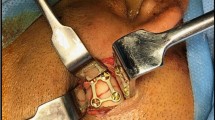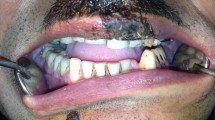Abstract
Purpose
The purpose of this study is to determine the amount of ramal height shortening and degree of displacement of sub condylar fracture that should be considered for effective management of mandibular sub condylar fractures using cone-beam computed tomography.
Patients and Methods
A prospective study of forty-two patients, who presented with unilateral sub condylar fracture was done. All patients were classified into Class I, II and III based on the degree of displacement of fractured segment and amount of ramal height shortening measured using cone-beam computed tomography. The treatment protocol was closed reduction and maxillomandibular fixation for Class I patients and open reduction and internal fixation for Class II and III patients. Outcomes of treatment were measured postoperatively 2 weeks, 1 and 3 months clinically. The variables, such as mouth opening, lateral and protrusive movements, deviation, pain and occlusion were studied.
Results
Among forty-two patients, twenty had Class I fractures, twelve had Class II fractures and ten had Class III fractures. Overall, no statistically significant differences were found between Class I and Class II groups in terms of functional outcomes and there were statistically significant differences between Class I and III groups. Class I fractures can be considered for closed method and open reduction is recommended for Class II and III fractures. The sample was composed of 42 patients grouped as follows: Class I (n = 20), Class II (n = 12), and Class III (n = 10) for treatment of sub condylar fractures. There were no significant differences between the three groups for the study variables at baseline, except for mouth opening and pain. There was significant difference in mouth opening between Class I and III cases (p 0.001) and insignificant difference in mouth opening in Class I and II cases (p 0.98). Persistent pain was elicited more in surgical Class II and III (n = 5) than non-surgical cases Class I (n = 0) on 3 months follow-up.
Conclusion
The study emphasises on use of three-dimensional diagnostic modality like cone-beam computed tomography for accurately classifying sub condylar fractures. The results favour closed reduction for mildly displaced Class I cases and surgical management of significantly displaced Class III fractures. The need for open reduction for Class II patients classified using CBCT is negligible assessing risks associated with surgical procedure which is contradictory to our protocol which requires a further comparative evaluation among Class II group.




Similar content being viewed by others
References
Zachariades N, Mezitis M, Mourouzis C, Papadakis D, Spanou A (2006) Fractures of the mandibular condyle: a review of 466 cases: literature review, reflections on treatment and proposals. J Cranio-Maxillofac Surg 34(7):421–432
Sawazaki R, Jünior S, Asprino L, Moreira R, de Moraes M (2010) Incidence and patterns of mandibular condyle fractures. J Oral Maxillofac Surg 68(6):1252–1259
Kaeppler G, Cornelius CP, Ehrenfeld M, Mast G (2013) Diagnostic efficacy of cone-beam computed tomography for mandibular fractures. Oral Surg Oral Med Oral Pathol Oral Radiol 116(1):98–104
Lindahl L (1977) Condylar fractures of the mandible. Int J Oral Surg 6:1221
Ellis E III, Palmieri C, Throckmorton GS (1999) Further displacement of condylar process fractures after closed treatment. J Oral Maxillofac Surg 59(2):120e9
Bhagol A, Singh V, Kumar I (2011) Classification system for the management of mandibular sub condylar fractures. J Oral Maxillofac Surg 69(4):1159–1165
Strobl H, Emshoff R, Röthler G (1999) Conservative treatment of unilateral condylar fractures in children: a long-term clinical and radiologic follow-up of 55 patients. Int J Oral Maxillofac Surg 28(2):95–98.
Author information
Authors and Affiliations
Corresponding author
Additional information
Publisher's Note
Springer Nature remains neutral with regard to jurisdictional claims in published maps and institutional affiliations.
Rights and permissions
Springer Nature or its licensor (e.g. a society or other partner) holds exclusive rights to this article under a publishing agreement with the author(s) or other rightsholder(s); author self-archiving of the accepted manuscript version of this article is solely governed by the terms of such publishing agreement and applicable law.
About this article
Cite this article
Vidhya, V., Dominic, S., Mohan, S. et al. Outcome of Management of Mandibular Sub condylar Fractures Based on Classification System Using Cone-Beam Computed Tomography. J. Maxillofac. Oral Surg. 22, 453–459 (2023). https://doi.org/10.1007/s12663-023-01868-w
Received:
Accepted:
Published:
Issue Date:
DOI: https://doi.org/10.1007/s12663-023-01868-w




